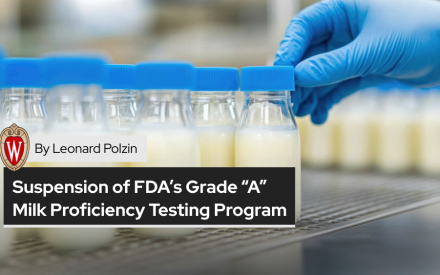Farm Bill
The farm bill is an omnibus, multiyear law that governs an array of agricultural and food programs. It provides an opportunity for policymakers to comprehensively and periodically address agricultural and food issues. In addition to developing and enacting farm legislation, Congress is involved in overseeing its implementation. The farm bill typically is renewed about every five years. Since the 1930s, Congress has enacted 18 farm bills.
History and Developments of Farm Bills
Historically, dairy has been a component of most Farm Bills. History and gradual developments in farm bills are discussed below with an overview focusing on dairy-related provisions:
1930s: Agricultural Adjustment Act of 1933
The first Farm Bill sought to elevate depressed commodity prices by paying farmers to reduce output. The Dairy Production Adjustment Program paid dairy farmers to reduce the number of dairy cows and production of milk. The 1938 Farm Bill continued these efforts, laying the groundwork for the Federal Milk Marketing Orders, which facilitate the calculation of market-based minimum uniform milk prices that handlers must pay to producers and facilitate orderly marketing.
1949: The Agricultural Act
The Agricultural Act of 1949 is often referred to as the “permanent law” for dairy and agricultural programs. It established a price support system where the government purchases surplus dairy products using a defined reference price calculation to maintain a floor on milk prices. If a current Farm Bill is not passed or extended, legislation reverts to the laws established under this piece of legislation.
The support price established in this legislation can be adjusted based on various factors, such as changes in the cost of production, market conditions, and parity prices. If the market price falls below the support price, the government may step in and purchase surplus dairy products at the support price to help stabilize the market.
1970s and 1980s: Consolidation, Price Supports and Herd Reduction Programs
The 1970s and 80s saw several pieces of dairy-specific legislation, including the Dairy Production Stabilization Act of 1983. The Dairy Price Support Program aimed to keep dairy prices stable by purchasing surplus butter, cheese, and nonfat dry milk at specified prices. Given surplus production and low prices, the 1985 Farm Bill included the Dairy Termination Program, which paid farmers to slaughter dairy cattle and exit the industry for five years. The Milk Diversion Program also encouraged farmers to reduce milk production by providing them financial incentives.
The Milk Diversion Program was a temporary initiative enacted by the U.S. Congress in 1983 and was in effect from January 1984 to March 1985. The program was designed to address the excessive purchases of dairy products and the costs associated with maintaining the dairy price support program. Under the Milk Diversion Program, for every hundredweight of milk production not produced relative to their established base level of production, dairy farmers were paid $10.
- Farmers were paid to reduce their milk marketing’s by 5% to as much as 30%.
- Approximately 38,000 commercial dairy operations in the U.S. participated in the Milk Diversion Program.
- Total milk diversion payments were $955 million, and it was estimated that milk production was reduced by 3.74 billion to 4.11 billion pounds in 1984.
- The program was funded through a farmer assessment of $0.50/cwt.
- The aim of the program was to curb the surplus of milk and dairy products, thereby reducing the costs associated with maintaining the dairy price support program.
1996: Freedom to Farm Act
The Federal Agriculture Improvement and Reform Act of 1996 (P.L. 104-127) is informally known as the Freedom to Farm Act, the FAIR Act, or the 1996 U.S. Farm Bill. It was enacted by the 104th United States Congress and became effective on April 4, 1996.
- The Act aimed to revise and simplify direct payment programs for crops and eliminate milk price support through direct government purchases.
- It removed the link between income support payments and farm prices.
- The Act authorized 7-year production flexibility contract payments that provided participating producers with fixed government payments independent of current farm prices and production.
- It increased planting flexibility by allowing participants to plant 100% of their total contract acreage to any crop, with limitations on fruits and vegetables.
- The authority for acreage reduction programs was eliminated, while nonrecourse loans (with marketing loan repayment provisions) were continued in a modified form.
- The Act also had provisions for phasing down dairy price supports over 4 years and then eliminating it, but subsequent legislation continued this program.
Development of the Freedom to Farm Act summarized in table below
| Time Period | Event | Description |
|---|---|---|
| Pre-1996 | Pre-Freedom to Farm Act Era | U.S. farm policy since the Agricultural Adjustment of 1933 had included acreage set aside, which limited farmers’ “freedom” to decide what crops to plant. |
| 1996 | Enactment of the Freedom to Farm Act | The Act was enacted by the 104th United States Congress and became effective on April 4, 1996. It aimed to revise and simplify direct payment programs for crops and eliminate milk price support through direct government purchases. |
| Post-1996 | Changes Brought by the Act | The Act eliminated acreage set asides, allowing farmers more freedom in deciding what crops to plant. It also reauthorized the Food Stamp Program for 2 years and commodity donation programs for 7 years. Furthermore, it established a Fund for Rural America to augment existing resources for agricultural research and rural development. |
Thus, the 1996 Farm Bill aimed to transition the agricultural sector, including dairy, toward a market-oriented approach. While the dairy price support program was retained, the intention was to gradually reduce government intervention. However, market conditions led to additional support measures.
2002 and 2008: Milk Income Loss Contract (MILC) Program
The 2002 Farm Bill introduced the Milk Income Loss Contract (MILC) program, providing payments to producers when milk prices declined below a determined level. The 2008 update to the MILC program adjusted the program to account for feed costs, offering a more comprehensive safety net.
The MILC program was introduced by the United States Department of Agriculture (USDA) as part of the 2002 Farm Bill. The program was designed to compensate dairy producers when domestic milk prices fell below a specified level.
- The program was initially authorized through September 30, 2005, and later extended through September 30, 2007.
- Eligible dairy producers were those who commercially produce and market cow milk in the United States from December 1, 2001, through September 30, 2007.
- The USDA’s Farm Service Agency (FSA) makes MILC payments on a monthly basis when the Boston Class I milk price falls below $16.94/cwt.
- The payment rate is determined by subtracting the Boston Class I price for that month from the $16.94 baseline, and multiplying the difference by a certain percentage which varies depending on the period.
2014: Introduction of Margin Protection Program
The 2014 Farm Bill replaced MILC and price support with the Margin Protection Program for Dairy Producers (MPP-Dairy). This program provided dairy operations with risk management tools, allowing producers to insure against low margins between milk prices and feed costs.
- MPP-Dairy was a voluntary risk management program that provided financial assistance to dairy producers when the difference between the price of milk and the cost of feed (the margin) fell below the coverage levels (trigger) the producer chooses on an annual basis.
- The program was authorized by the 2014 Farm Bill through Dec. 31, 2018.
- The 2018 Farm Bill authorized the new Dairy Margin Coverage (DMC) program, which replaced the MPP-Dairy.
Much like the MPP-Dairy program, the DMC program is a voluntary program that provides dairy operations with risk management coverage that will pay producers when the difference (the margin) between the national price of milk and the average cost of feed falls below a certain level selected by the program participants.
The 2014 Farm Bill, also known as The Agriculture Act of 2014, was a bundle of legislation passed by Congress that set national agriculture, nutrition, conservation, and forestry policy. It authorized $956 billion in spending over ten years. The bill made major changes in commodity programs, added new crop insurance options, streamlined conservation programs, modified some provisions of the Supplemental Nutrition Assistance Program (SNAP), and expanded programs for specialty crops, organic farmers, bioenergy, rural development, and beginning farmers and ranchers.
2018: Dairy Margin Coverage
The 2018 Farm Bill introduced the Dairy Margin Coverage (DMC) program, replacing MPP-Dairy. DMC provides more flexibility and coverage options and also includes provisions for small and medium-sized operations. Additionally, the Dairy Revenue Protection (DRP) and Livestock Gross Margin for Dairy Cattle (LGM-Dairy) insurance programs were introduced to offer further risk management tools.
The DMC program was introduced in 2018 as part of the Agricultural Improvement Act. The DMC is a voluntary risk management program that provides financial assistance to dairy producers when the difference between the price of milk and the average feed price (the margin) falls below a certain dollar amount selected by the producer.
- The DMC replaced the Margin Protection Program for Dairy (MPP-Dairy), which was authorized by the 2014 Farm Bill.
- The DMC offers protection to dairy producers when the difference between the all-milk price and the average feed price falls below a certain dollar amount selected by the producer.
- The DMC decision tool was developed in partnership with representatives from the University of Minnesota and University of Wisconsin to help producers determine the level of coverage under a variety of conditions that will provide them with the strongest financial safety net.
- At a milk margin minus feed costs of $9.50/cwt or less, DMC payments are possible depending on the level of coverage chosen by the dairy producer.
- To be eligible for DMC, a dairy operation must produce and commercially market milk from cows located in the United States, and provide proof of milk production at the time of registration.
The DMC program continues to offer protection to dairy producers, helping them manage risks associated with fluctuating milk and feed prices.
Each Farm Bill has addressed various aspects of the dairy sector, aiming to address challenges and opportunities in the industry. Consequently, dairy provisions have undergone adjustments over the years in response to shifts in economic conditions, environmental considerations, and technological advancements.
Farm Bill Extension Prerequisites
If a new Farm Bill is not passed on time, Congress has the option to extend current legislation. The process of extending a Farm Bill generally involves legislative action to continue the provisions of the expiring or expired Farm Bill for a specified period. This is usually accomplished through a “continuing resolution” or a specific “extension bill” that retains the key elements of the previous legislation.
Congressional Action
Congressional action in the realm of agricultural policy is fundamental to the creation, modification, and oversight of farm bills and related legislation. It involves the collaborative efforts of elected representatives to shape agricultural policy in response to evolving needs. Below are the steps typically involved in extending a Farm Bill:
- Legislative Proposal: Members of Congress introduce a bill proposing the extension of the current Farm Bill, specifying which titles or programs will be extended and for what duration.
- Committee Review: The bill is referred to the relevant committees, commonly the House Committee on Agriculture and the Senate Committee on Agriculture, Nutrition, and Forestry. These committees review the bill, and may hold hearings or make amendments.
- Floor Debate and Vote: Following committee approval, the bill is sent to the floor of each chamber for debate. Subsequent to the debate, a vote is taken.
- Reconciliation: If the House and Senate versions of the bill differ, a conference committee is formed to reconcile the differences. Both chambers then vote on the reconciled bill.
- Presidential Assent: The final version of the bill is sent to the President for signature. Once signed, the extension becomes law, continuing the provisions of the previous Farm Bill for the specified time period.
Whole discussion of action represented in table below
| Step | Description |
|---|---|
| 1. Congressional Action | Initiation of legislative process to extend the current Farm Bill. |
| 2. Legislative Proposal | Members of Congress introduce an extension bill, specifying the titles or programs to be extended and the duration of the extension. |
| 3. Committee Review | The proposed bill is sent to relevant committees, usually the House Committee on Agriculture and the Senate Committee on Agriculture, Nutrition, and Forestry. These committees review the bill and may hold hearings or make amendments. |
| 4. Floor Debate and Vote | After committee approval, the bill moves to the floor of each legislative chamber for debate. A vote is taken following the debate. |
| 5. Reconciliation | In case of discrepancies between the House and Senate versions of the bill, a conference committee is formed to reconcile the differences. Both chambers then vote on the reconciled version. |
| 6. Presidential Assent | The final reconciled bill is sent to the President for signature. Upon signing, the extension becomes law, thereby continuing the provisions of the previous Farm Bill for the specified time period. |
Factors Influencing the Extension of Bill
- Duration: The length of the extension can vary, ranging from a few months to a full year or more, depending on legislative and political considerations.
- Funding: The extension bill needs to outline how the extended programs will be funded, which can be a point of negotiation among lawmakers.
- Program-Specific Provisions: Some programs may receive particular attention in the extension, either receiving special funding or undergoing temporary modifications.
- Political and Economic Context: The likelihood and nature of an extension can be influenced by broader political or economic factors, such as upcoming elections, budget constraints, or significant events affecting the agriculture sector.
- Stakeholder Input: Agricultural producers, industry groups, and other stakeholders may have input into the extension process, either through formal consultations or advocacy efforts.
An extension is generally considered a stop-gap measure intended to provide continuity and stability until a new Farm Bill can be enacted. It ensures that essential programs and services, such as commodity price supports, conservation programs, and nutritional assistance, continue to operate.
Possible Implications if the current Farm Bill expires without extension
The expiration of a Farm Bill without an ensuing extension has various implications for agricultural programs, commodity markets, and other sectors addressed in the legislation. The following outlines the primary consequences:
1. Reversion to Permanent Law
The Agricultural Act of 1949 serves as the United States’ “permanent law” for farm policy and provides the foundational guidelines that would come back into effect should a current Farm Bill expire without an extension. For the dairy industry, two key components of this permanent law are federal milk marketing orders and parity pricing.
The dairy industry would revert to the provisions established by the Agricultural Act of 1949, which includes a framework for federal milk marketing orders and parity pricing. This reversion could result in substantial increases in the government-supported price of milk, which might distort both the domestic and international markets.
2. Federal Milk Marketing Orders
Federal Milk Marketing Orders (FMMOs) are a mechanism to facilitate orderly marketing conditions. Established first in the 1930s and incorporated into the 1949 Act, FMMOs facilitate the calculation of market-based minimum uniform milk prices that handlers must pay to producers. These orders are regionally based and account for local conditions, but reverting to permanent law could rigidify these orders and eliminate flexibility added in more recent Farm Bills.
In the context of an expired Farm Bill, the FMMOs under the 1949 Act might not reflect current market dynamics or logistical frameworks. For example, current FMMOs are more nuanced in accounting for various uses of milk—from fluid consumption to cheese and yogurt production—which could be disrupted, leading to inefficient allocation of milk supplies and market distortions.
3. Parity Pricing
Parity pricing aims to give farmers the same relative purchasing power for their products that they had during a base period, which for dairy was 1910-1914. Under permanent law, this would involve setting the price of milk at a level that reflects changes in the Consumer Price Index and other inflationary factors since that time. These support prices would be considerably higher than current market prices. Should the dairy industry revert to these provisions, the government-supported price of milk could see a substantial increase. This would likely result in several outcomes:
- Market Distortions: High government-set prices could incentivize overproduction, leading to supply-demand imbalances. This could force the government to purchase and store significant amounts of dairy products, incurring high costs.
- Consumer Impact: The elevated floor price would almost certainly translate into higher retail prices for dairy products, reducing consumer demand domestically.
- International Competitiveness: High domestic prices could make U.S. dairy products less competitive on the global market, affecting exports and potentially leading to a loss of market share.
- Resource Allocation: The high price might induce more producers to enter the dairy sector or dissuade existing producers from exiting, potentially diverting resources from more efficient uses.
- Contractual and Legal Complications: Existing contracts based on current Farm Bill provisions might face challenges, adding another layer of uncertainty to the industry.
Reverting to the 1949 Agricultural Act provisions could result in considerable disruptions for the dairy industry. The frameworks set at that time for federal milk marketing orders and parity pricing might be unsuited to today’s market conditions and could lead to various economic inefficiencies and uncertainties.
4. Market Instability
The reversion to higher support prices under permanent law could lead to disruptions in the dairy market. Consumers could see a significant increase in the retail prices of milk and dairy products, potentially reducing demand. Additionally, artificially high prices could encourage overproduction, leading to longer-term market imbalances.
5. Disruption of Risk Management Programs
Modern Farm Bills usually include risk management tools tailored for the dairy industry, such as the Dairy Margin Coverage program. The expiration of the Farm Bill would mean that these tools would no longer be available for enrollment, limiting dairy producers’ ability to manage risk effectively.
6. Halt in Market Promotion and Research
Programs aimed at promoting dairy consumption, as well as research and development efforts focused on dairy, may lose their authorization for funding. This could impact the competitiveness and sustainability of the industry.
7. Policy and Regulatory Uncertainties
Contracts, grants, or other arrangements made under the authorities of the expired Farm Bill could face legal challenges or uncertainties, complicating compliance and enforcement mechanisms.
Conclusion
Allowing a Farm Bill to expire without an extension would likely introduce significant instability and uncertainty into the dairy sector. Such impacts could include market distortions and the loss of vital risk management tools, potentially jeopardizing the economic sustainability of the industry. Therefore, it is improbable that legislative action would be allowed to lapse and revert to laws established by the Agricultural Act of 1949.


 Milk, Cookies, and Christmas Eve: Santa’s Dairy Tab by the Numbers
Milk, Cookies, and Christmas Eve: Santa’s Dairy Tab by the Numbers Dairy Market Dynamics and Domestic Constraints: A Dairy Sector Assessment as of June 2025
Dairy Market Dynamics and Domestic Constraints: A Dairy Sector Assessment as of June 2025 U.S.–Canada Dairy Trade Relationship (2025–Present)
U.S.–Canada Dairy Trade Relationship (2025–Present) Suspension of FDA’s Grade “A” Milk Proficiency Testing Program – A Comprehensive Analysis
Suspension of FDA’s Grade “A” Milk Proficiency Testing Program – A Comprehensive Analysis


